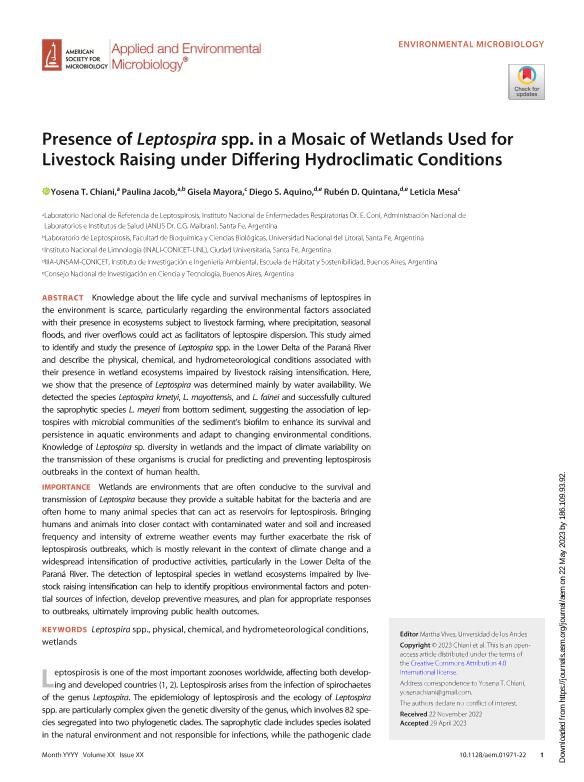Mostrar el registro sencillo del ítem
dc.contributor.author
Chiani, Yosena

dc.contributor.author
Jacob, Paulina

dc.contributor.author
Mayora, Gisela Paola

dc.contributor.author
Aquino, Diego Sebastián

dc.contributor.author
Quintana, Ruben Dario

dc.contributor.author
Mesa, Leticia Mariana

dc.date.available
2024-02-06T13:33:49Z
dc.date.issued
2023-04
dc.identifier.citation
Chiani, Yosena; Jacob, Paulina; Mayora, Gisela Paola; Aquino, Diego Sebastián; Quintana, Ruben Dario; et al.; Presence of Leptospira spp. in a Mosaic of Wetlands Used for Livestock Raising under Differing Hydroclimatic Conditions; American Society for Microbiology; Applied and Environmental Microbiology; 89; 6; 4-2023; 1-12
dc.identifier.issn
0099-2240
dc.identifier.uri
http://hdl.handle.net/11336/225927
dc.description.abstract
Knowledge about the life cycle and survival mechanisms of leptospires in the environment is scarce, particularly regarding the environmental factors associated with their presence in ecosystems subject to livestock farming, where precipitation, seasonal floods, and river overflows could act as facilitators of leptospire dispersion. This study aimed to identify and study the presence of Leptospira spp. in the Lower Delta of the Paraná River and describe the physical, chemical, and hydrometeorological conditions associated with their presence in wetland ecosystems impaired by livestock raising intensification. Here, we show that the presence of Leptospira was determined mainly by water availability. We detected the species Leptospira kmetyi, L. mayottensis, and L. fainei and successfully cultured the saprophytic species L. meyeri from bottom sediment, suggesting the association of leptospires with microbial communities of the sediment's biofilm to enhance its survival and persistence in aquatic environments and adapt to changing environmental conditions. Knowledge of Leptospira sp. diversity in wetlands and the impact of climate variability on the transmission of these organisms is crucial for predicting and preventing leptospirosis outbreaks in the context of human health. IMPORTANCE Wetlands are environments that are often conducive to the survival and transmission of Leptospira because they provide a suitable habitat for the bacteria and are often home to many animal species that can act as reservoirs for leptospirosis. Bringing humans and animals into closer contact with contaminated water and soil and increased frequency and intensity of extreme weather events may further exacerbate the risk of leptospirosis outbreaks, which is mostly relevant in the context of climate change and a widespread intensification of productive activities, particularly in the Lower Delta of the Paraná River. The detection of leptospiral species in wetland ecosystems impaired by livestock raising intensification can help to identify propitious environmental factors and potential sources of infection, develop preventive measures, and plan for appropriate responses to outbreaks, ultimately improving public health outcomes.
dc.format
application/pdf
dc.language.iso
eng
dc.publisher
American Society for Microbiology

dc.rights
info:eu-repo/semantics/openAccess
dc.rights.uri
https://creativecommons.org/licenses/by-nc-sa/2.5/ar/
dc.subject
AND HYDROMETEOROLOGICAL CONDITIONS
dc.subject
CHEMICAL
dc.subject
LEPTOSPIRA SPP.
dc.subject
PHYSICAL
dc.subject
WETLANDS
dc.subject.classification
Biología Celular, Microbiología

dc.subject.classification
Ciencias Biológicas

dc.subject.classification
CIENCIAS NATURALES Y EXACTAS

dc.title
Presence of Leptospira spp. in a Mosaic of Wetlands Used for Livestock Raising under Differing Hydroclimatic Conditions
dc.type
info:eu-repo/semantics/article
dc.type
info:ar-repo/semantics/artículo
dc.type
info:eu-repo/semantics/publishedVersion
dc.date.updated
2024-02-06T11:05:44Z
dc.journal.volume
89
dc.journal.number
6
dc.journal.pagination
1-12
dc.journal.pais
Estados Unidos

dc.journal.ciudad
Washington
dc.description.fil
Fil: Chiani, Yosena. Dirección Nacional de Instituto de Investigación. Administración Nacional de Laboratorios e Instituto de Salud "Dr. C. G. Malbran". Instituto Nacional de Enfermedades Respiratorias; Argentina
dc.description.fil
Fil: Jacob, Paulina. Universidad Nacional del Litoral; Argentina. Dirección Nacional de Instituto de Investigación. Administración Nacional de Laboratorios e Instituto de Salud "Dr. C. G. Malbran". Instituto Nacional de Enfermedades Respiratorias; Argentina
dc.description.fil
Fil: Mayora, Gisela Paola. Consejo Nacional de Investigaciones Científicas y Técnicas. Centro Científico Tecnológico Conicet - Santa Fe. Instituto Nacional de Limnología. Universidad Nacional del Litoral. Instituto Nacional de Limnología; Argentina
dc.description.fil
Fil: Aquino, Diego Sebastián. Universidad Nacional de San Martín. Instituto de Investigación e Ingeniería Ambiental. - Consejo Nacional de Investigaciones Científicas y Técnicas. Oficina de Coordinación Administrativa Parque Centenario. Instituto de Investigación e Ingeniería Ambiental; Argentina
dc.description.fil
Fil: Quintana, Ruben Dario. Universidad Nacional de San Martín. Instituto de Investigación e Ingeniería Ambiental. - Consejo Nacional de Investigaciones Científicas y Técnicas. Oficina de Coordinación Administrativa Parque Centenario. Instituto de Investigación e Ingeniería Ambiental; Argentina
dc.description.fil
Fil: Mesa, Leticia Mariana. Consejo Nacional de Investigaciones Científicas y Técnicas. Centro Científico Tecnológico Conicet - Santa Fe. Instituto Nacional de Limnología. Universidad Nacional del Litoral. Instituto Nacional de Limnología; Argentina
dc.journal.title
Applied and Environmental Microbiology

dc.relation.alternativeid
info:eu-repo/semantics/altIdentifier/url/https://journals.asm.org/doi/10.1128/aem.01971-22
dc.relation.alternativeid
info:eu-repo/semantics/altIdentifier/doi/http://dx.doi.org/10.1128/aem.01971-22
Archivos asociados
